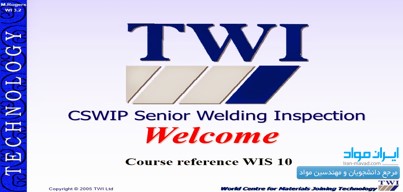
دنیای جوشکاری
دنیایی از مطالب جوشکاری و بازرسی فنی
دنیای جوشکاری
دنیایی از مطالب جوشکاری و بازرسی فنیمقایسه جوشکاری EBW و اتصال خود فشاری حرارتی برای آلیاژ Ti6Al4V
A comparative study on electron beam welding and
rigid restraint thermal self-compressing bonding for Ti6Al4V alloy
بررسی مقایسه ای جوشکاری پرتوی الکترونی
و اتصال خود فشاری حرارتی سخت مقیدشده برای آلیاژ Ti6Al4V

ABSTRACT
This study focuses on the influence of joining method difference on the joint microstructure and properties. Unlike vacuum electron beam welding (EBW) utilizing electron beam as fusion heat source, rigid restraint thermal self-compressing bonding (TSCB), a new solid-state bonding method proposed by authors, employs vacuum electron beam as the non-melt heat source to bond materials in this work. Meanwhile, a comparative study on the microstructure and mechanical properties of EBWjoint and rigid restraint TSCB joint was conducted to investigate the effect of this difference on joint microstructure and properties. Results show that compared with EBW joints, the rigid restraint TSCB joints as solid-state joints are homogeneous in terms of microstructure and microhardness profile. Strength of both joints are comparable with that of base metal, but the elongation of the rigid restraint TSCB joint is more close to that of base metal. Rigid restraint TSCB joint has better combination of strength and ductility.
![]()
اتصال آلیاژهای آلومینیوم 5083 و 6061 به روش جوشکاری اصطکاکی
Joining of 5083 and 6061 aluminum alloys by friction stir welding
اتصال آلیاژهای آلومینیوم 5083 و 6061 به روش جوشکاری اصطکاکی تلاطمی

ABSTRACT
Friction stir welding (FSW) has emerged as a new solid state joining technique [1], especially for aluminum alloys [2–6]. In this process, a rotating tool travels down the length of contacting metal plates, and produces a highly plastically deformed zone through the associated stirring action. The localized heating zone is produced by friction between the tool shoulder and the plate top surface, as well as plastic deformation of the material in contact with the tool [1].
At the present time, FSW is used mainly for joining similar materials. For dissimilar welding, there have been few systematic studies aimed at clarifying the effect of material combination and welding conditions on weld properties [7, 8].
![]()
چقرمگی شکست یک فولاد ضدزنگ سوپر داپلکس جوشکاری شده
Fracture toughness of a welded super duplex stainless steel
چقرمگی شکست یک فولاد ضدزنگ سوپر داپلکس جوشکاری شده

ABSTRACT
Fracture toughness testing was conducted on standard single-edge notched bend bar specimens of base and weld metal. The material was the SAF 2906 super duplex stainless steel. The aim was to evaluate the susceptibility for brittle failure at sub-zero temperatures for the base and weld metal. The base metal was tested between −103 and −60 °C and was evaluated according to the crack-tip opening displacement method. The fracture event at and below −80 °C can be described as ductile until critical cleavage initiation occurs, which caused unstable failure of the specimen. The welding method used was submerged arc welding with a 7 wt% nickel filler metal. The welded specimens were post-weld heat treated (PWHT) at 1100 °C for 20 min and then quenched. Energy-dispersive X-ray spectroscopy analysis showed that during PWHT substitutional element partitioning occurred which resulted in decreased nickel content in the ferrite. The PWHT weld metal specimens were tested at −72 °C. The fracture sequence was critical cleavage fracture initiation after minor crack-tip blunting and ductile fracture.
![]() جهت دانلود رایگان نسخه لاتین این مقاله اینجا کلیک کنید .
جهت دانلود رایگان نسخه لاتین این مقاله اینجا کلیک کنید .
![]()
اسلاید جامع بازرسی جوش TWI CSWIP
اسلاید جامع بازرسی جوش TWI CSWIP
انستیتو جوشکاری بریتانیا

یک پاورپوینت بسیار کامل و جامع از “بازرسی جوش ” که کلیه مباحث مربوط به آن را پوشش داده و تشریح می کند . این پاورپوینت در قالب ۷۵۰ اسلاید کلیه مباحث را بهمراه نمودار ، عکس و فیلم ارائه نموده است که آنرا به تمامی فعالان عرصه جوش و بازرسی جوش توصیه و پیشنهاد می کنیم .
تهیه شده توسط انستیتو جوشکاری بریتانیا TWI
بازرسی جوش به منظور کنترل دقیق قطعات جوشکاری شده و برای حصول اطمینان از صحت انجام جوشکاری بر مبنای استانداردها و دستورالعمل های مشخص روی اتصالات جوش شده انجام می شود که این بررسی ها از جمله وظایف یکبازرسی جوش است. در واقع می توان گفت فرآیند های جوشکاری مانند دیگر پروسه های صنعتی دارای اصول و استاندارد های مشخصی می باشد. سازه های جوش داده شده نظیر سایز قطعات مهندسی به بازرسی در مراحل مختلف حین ساخت و به همان نسبت در خاتمه ساخت نیاز دارند . برای اطمینان یافتن از حصول کیفیت قابل قبول و مناسب در قطعات مختلف جوش شده، لازم است دستورالعمل های مربوط به جوشکاری بخوبی اجرا شوند. بازرسی و نظارت برجوشکاری صحیح تجهیزات جوش شونده از اهمیت بسزایی در تامین عمر مفید تجهیزات صنعتی اعم از خطوط لوله ، تجهیزات سدها ، سازه های فلزی ، مخازن ذخیزه ، مخازن تحت فشار ؛ کوره ها و غیره برخوردار اسـت .
مشاهده صفحه نمونه از این جزوه ( کلیک کنید )
قالب بندی : PPT
تعداد صفحات : ۷۵۰
حجم : ۱۱۵MB
